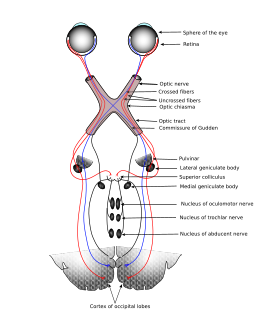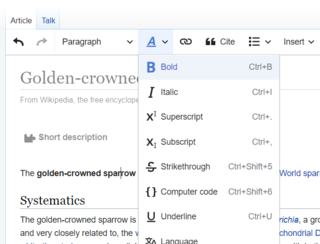
The visual cortex of the brain is that part of the cerebral cortex which processes visual information. It is located in the occipital lobe. Visual nerves run straight from the eye to the primary visual cortex to the Visual Association cortex.

Microsoft Visual C++ is an integrated development environment (IDE) product from Microsoft for the C, C++, and C++/CLI programming languages. MSVC is proprietary software; it was originally a standalone product but later became a part of Visual Studio and made available in both trialware and freeware forms. It features tools for developing and debugging C++ code, especially code written for the Windows API, DirectX and .NET.

Visual Basic .NET (VB.NET) is a multi-paradigm, object-oriented programming language, implemented on the .NET Framework. Microsoft launched VB.NET in 2002 as the successor to its original Visual Basic language. Although the ".NET" portion of the name was dropped in 2005, this article uses "Visual Basic [.NET]" to refer to all Visual Basic languages released since 2002, in order to distinguish between them and the classic Visual Basic. Along with Visual C#, it is one of the two main languages targeting the .NET framework.

The School of Visual Arts (SVA) is a for-profit art and design college in Manhattan, New York. It was founded in 1947, and is a member of the Association of Independent Colleges of Art and Design.

The visual system is the part of the central nervous system which gives organisms the ability to process visual detail as sight, as well as enabling the formation of several non-image photo response functions. It detects and interprets information from visible light to build a representation of the surrounding environment. The visual system carries out a number of complex tasks, including the reception of light and the formation of monocular representations; the buildup of a nuclear binocular perception from a pair of two dimensional projections; the identification and categorization of visual objects; assessing distances to and between objects; and guiding body movements in relation to the objects seen. The psychological process of visual information is known as visual perception, a lack of which is called blindness. Non-image forming visual functions, independent of visual perception, include the pupillary light reflex (PLR) and circadian photoentrainment.
Visual effects is the process by which imagery is created or manipulated outside the context of a live action shot in film making.
A Bachelor of Fine Arts is the standard undergraduate degree for students in the United States and Canada seeking a professional education in the visual or performing arts.

The occipital lobe is one of the four major lobes of the cerebral cortex in the brain of mammals. The occipital lobe is the visual processing center of the mammalian brain containing most of the anatomical region of the visual cortex. The primary visual cortex is Brodmann area 17, commonly called V1. Human V1 is located on the medial side of the occipital lobe within the calcarine sulcus; the full extent of V1 often continues onto the occipital pole. V1 is often also called striate cortex because it can be identified by a large stripe of myelin, the Stria of Gennari. Visually driven regions outside V1 are called extrastriate cortex. There are many extrastriate regions, and these are specialized for different visual tasks, such as visuospatial processing, color differentiation, and motion perception. The name derives from the overlying occipital bone, which is named from the Latin ob, behind, and caput, the head. Bilateral lesions of the occipital lobe can lead to cortical blindness.
A visual novel is an interactive game genre, which originated in Japan, featuring text-based story with narrative style of literature and interactivity aided by static or sprite-based visuals, most often using anime-style art or occasionally live-action stills. As the name might suggest, they resemble mixed-media novels.

Visual acuity (VA) commonly refers to the clarity of vision. Visual acuity is dependent on optical and neural factors, i.e., (i) the sharpness of the retinal focus within the eye, (ii) the health and functioning of the retina, and (iii) the sensitivity of the interpretative faculty of the brain.

Bandai Visual Co., Ltd. (Formerly known as AE Planing, Network Frontier and Bandai Media, was a Japanese anime, film production and distribution enterprise, established by Bandai Company, Limited and a subsidiary of Bandai Namco Holdings, Inc.

Microsoft Visual Studio Express is a set of integrated development environments (IDEs) developed by Microsoft as a freeware and registerware function-limited version of the non-free Microsoft Visual Studio. Express editions started with Visual Studio 2005.
Visual impairment, also known as vision impairment or vision loss, is a decreased ability to see to a degree that causes problems not fixable by usual means, such as glasses. Some also include those who have a decreased ability to see because they do not have access to glasses or contact lenses. Visual impairment is often defined as a best corrected visual acuity of worse than either 20/40 or 20/60. The term blindness is used for complete or nearly complete vision loss. Visual impairment may cause people difficulties with normal daily activities such as driving, reading, socializing, and walking.
Visual geography is the study of geography as represented in paintings, photos and other forms of the visual arts. Both human geography and physical geography in the visual arts are studied. Typical studies in Visual Geography include the geographical symbols within visual arts. Another is cross referencing the date a piece of visual art was produced with known weather records to see if the art was drawn accurately in the field or from memory in a studio.

Visual Basic is a third-generation event-driven programming language from Microsoft for its Component Object Model (COM) programming model first released in 1991 and declared legacy during 2008. Microsoft intended Visual Basic to be relatively easy to learn and use. Visual Basic was derived from BASIC and enables the rapid application development (RAD) of graphical user interface (GUI) applications, access to databases using Data Access Objects, Remote Data Objects, or ActiveX Data Objects, and creation of ActiveX controls and objects.

Microsoft Visual Studio is an integrated development environment (IDE) from Microsoft. It is used to develop computer programs, as well as websites, web apps, web services and mobile apps. Visual Studio uses Microsoft software development platforms such as Windows API, Windows Forms, Windows Presentation Foundation, Windows Store and Microsoft Silverlight. It can produce both native code and managed code.
Visual perception is the ability to interpret the surrounding environment using light in the visible spectrum reflected by the objects in the environment. This is different from visual acuity, which refers to how clearly a person sees. A person can have problems with visual perceptual processing even if he/she has 20/20 vision.

The visual arts are art forms such as painting, drawing, printmaking, sculpture, ceramics, photography, video, filmmaking, design, crafts, and architecture. Many artistic disciplines involve aspects of the visual arts as well as arts of other types. Also included within the visual arts are the applied arts such as industrial design, graphic design, fashion design, interior design and decorative art.

VisualEditor (VE) is a project to provide a "visual" or "WYSIWYG-like" online rich-text editor as a MediaWiki extension to Wikipedia. It was developed by the Wikimedia Foundation in partnership with Wikia. In July 2013 the beta was enabled by default, with the ability to opt-out, for Mediawiki.org and several of the largest Wikipedias.

Visual Studio Code is a source-code editor developed by Microsoft for Windows, Linux and macOS. It includes support for debugging, embedded Git control and GitHub, syntax highlighting, intelligent code completion, snippets, and code refactoring. It is highly customizable, allowing users to change the theme, keyboard shortcuts, preferences, and install extensions that add additional functionality. The source code is free and open source and released under the permissive MIT License. The compiled binaries are freeware and free for private or commercial use.















